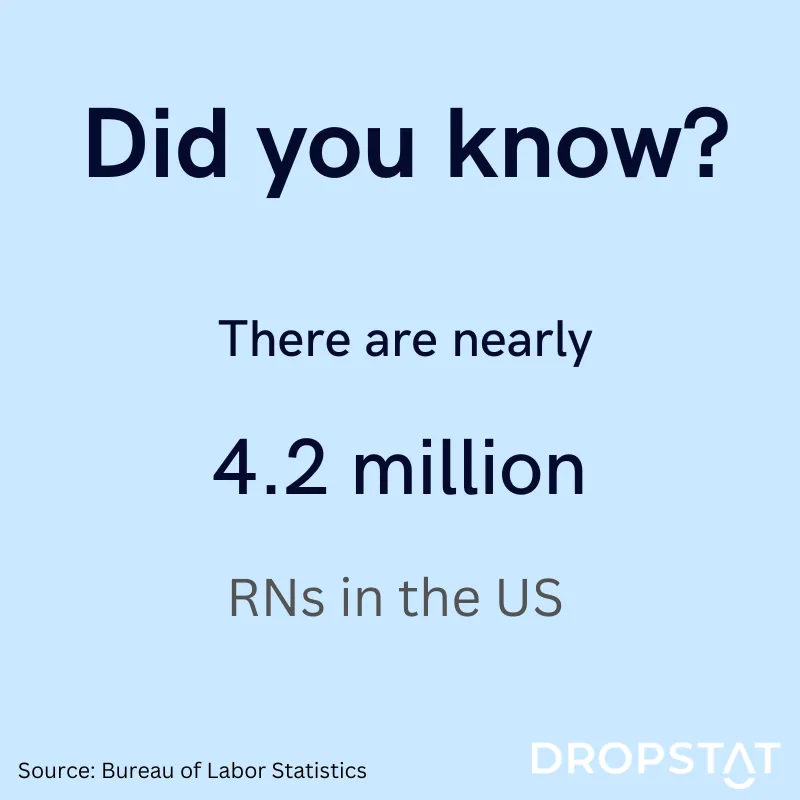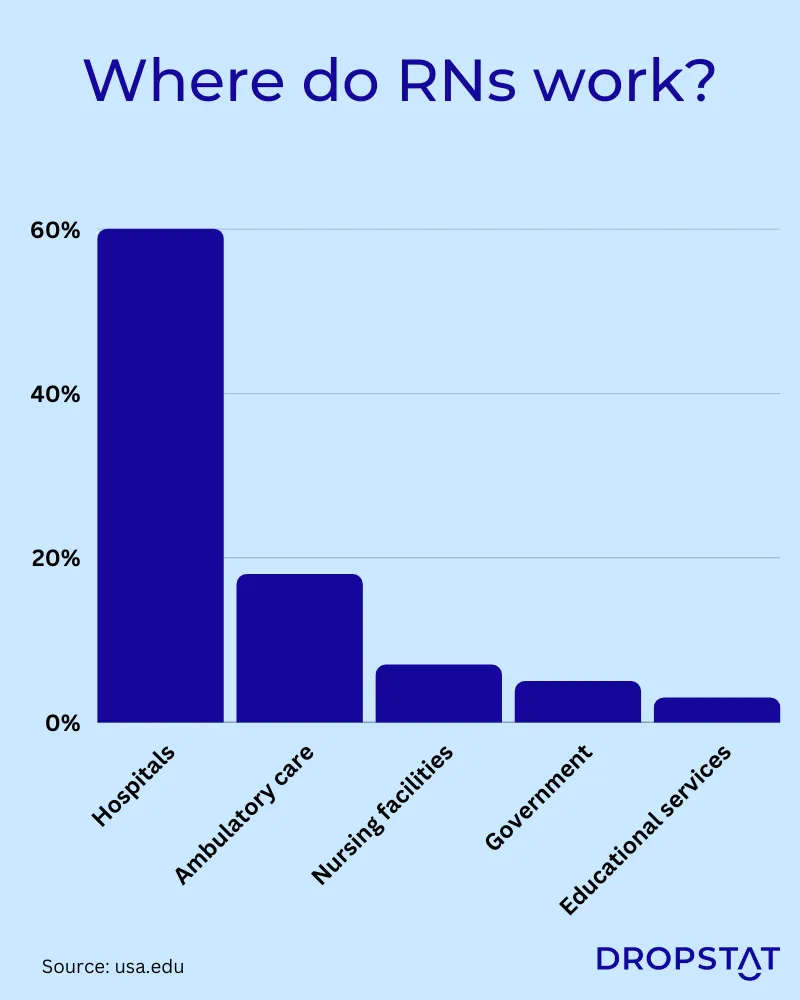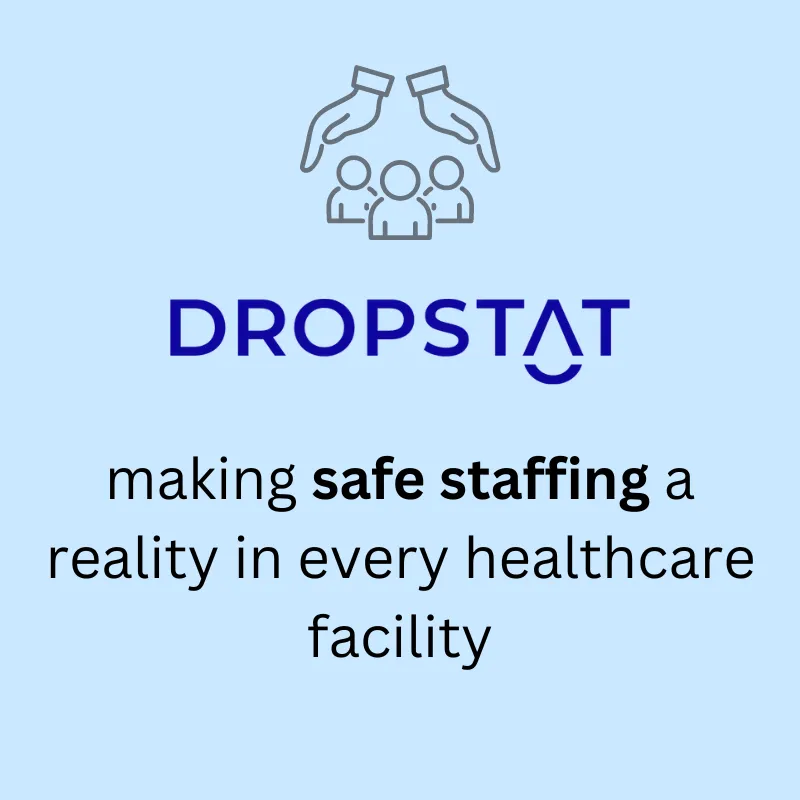Dropstat’s Clickable Guide to Types of Nursing Specialties
RN scope of practice and hierarchy
What is an RN? Like LPNs, CNAs, and other assistive nursing roles, RNs may provide direct patient care. However, their extensive training and educational background allow them to take on additional duties with greater responsibility. Some RN care tasks include:
- Generating and executing effective care plans
- Administering and tracking medication
- Completing wound care that lower-level nurses are not licensed to oversee
- Charting and validating patient records
- Recording patient medical history
- Collecting lab specimens
- Managing lower-level nurses, nursing students, and nurses in training
- Interpreting results of test analyses
- Maintaining communication with physicians and other medical professionals
Even with the additional education and training background, there are some aspects of patient care that RNs cannot complete. Some of these areas are:
- Writing medication prescriptions
- Offering diagnoses
- Participating in surgeries and procedures
- Offering treatment plans
- Referring patients to other providers
Given that RNs oversee other nurses, you may wonder where RNs rank within the nursing hierarchy. RNs working in hospitals are usually in the middle of the hierarchy, with LPNs and CNAs below them and APRNs (Advanced Practice Registered Nurses), nurse administrators, and nurse educators above them. This positions RNs to be a central component of delivering effective care.

RN training
Continuing education within nursing works to ensure that nursing professionals apply the most advanced practices, technology, and methods to their job while maintaining the most current knowledge on continuously changing regulations. Most states mandate continuing education as a requirement for active licensure. However, some states also request that nurses complete continuing education courses in certain nursing subjects.
Which healthcare facilities require RNs?
In many respects, registered nurses are the backbone of the healthcare industry, working as a direct link between physicians, patients, patient’s families, and lower-level nurses. Therefore, registered nurses are a vital aspect of virtually all healthcare settings. One can expect to see nurses working alongside other medical professions in:
- hospitals
- private practices
- physician’s offices
- birthing centers
- skilled nursing facilities
- nursing colleges and training hospitals
The most popular departments that use registered nurses include:
- Anesthesiology
- Critical-care
- Cardiology
- Obstetrics & Gynecology (OB-GYN)
- Oncology
- Pediatrics

What is the average RN salary?
The Bureau of Labor Statistics reports that the median RN salary is $77,600 annually. However, education, work setting, experience, location, and specialty are all factors that can influence pay. RNs that obtain an associate’s degree in nursing can expect to earn a salary of around $63,000 annually. Whereas an RN with a master’s degree in nursing can anticipate a yearly pay of around $90,000. Along with education, working as an operating room nurse or family nurse practitioner will command higher average pay than other specialties, as will individuals with greater experience in the field.
It is also important to note that nurse anesthesiologists earn around double the salary of a typical RN, considering that becoming a certified registered nurse anesthesiologist (CRNA) requires additional education.
Advanced RN programs that command higher pay
Certain high-demand skills also increase salary, and employers often pay for staff to complete these courses. The certifications that often correspond to higher pay are:
- Trauma Nursing Care Course (TNCC)
- Neonatal Resuscitation Program (NRP)
- Advanced Oncology Certified Nurse (AOCN)
- Basic Life Support (BLS)
- Emergency Room Pediatric Course (ENPC)
Travel RN Jobs
RN licenses are state-specific. Given that the ability to practice as a nurse depends on passing the NCLEX-RN exam, some states allow nurses with a valid license from another state to practice in theirs as well. The “compact nursing states” enable nurses in multiple states to freely practice in those parts of the Nurse Licensure Compact (NLC). However, states that are not part of the NLC (such as California and Oregon require an individual state-specific license as a requirement of practice.
Additionally, the scope of practice differs between states. Each state’s Nurse Practice Act (NPA) sets the guidelines for the scope of practice within their state.

Travel RN salary
Travel nurses demand higher pay than permanent RN staff, often increasing facility spending on temporary hires. The average salary for travel nurses in 2022 was $127,694, which is significantly more than the average salary of a permanent RN. Increased pay for travel nurses also depends on the nursing department they are assigned to, the location of their work, and the length of the contract.
RN vs. BSN
While RNs and BSNs are licensed to work as nursing professionals who have passed the NCLEX exam and completed the prerequisite requirements, some RNs do not have a nursing degree. BSN-RNs have earned both a degree in nursing and licensure to practice. Research has supported the correlation between a BSN degree and improved patient outcomes.
RN vs. LPN and CNA
Typically, LPN and CNA job duties emphasize activities of daily living and routine care tasks. In contrast, RNs are more responsible for determining care plans, dispensing medication that lower-level nurses can not administer, and interpreting test results. LPNs and CNAs are often under the direct supervision of RNs, increasing RN responsibility on the job.
RN vs. MSN
Similar to the difference between an RN and a BSN, the contrast between an RN and a Masters of Science in Nursing (MSN) is simply the fact that an RN refers to the licensure you are granted through your state, while an MSN refers to the level of education a nurse has earned. An MSN degree enables nurses to take on higher nursing roles such as being a nurse educator, nurse practitioner, clinical leader, and nurse informatics specialist.

What are the benefits of hiring RNs?
A facility often finds that its care teams lack staff that can complete higher-level nursing tasks such as administering medication or designing patient care plans. Rather than hiring agency staff to meet the shortcoming of the care team, facilities should make a greater effort to identify the specific shifts that require the advanced skills of RNs.
When RNs are prioritized, other care team members feel greater support and the ability to rely on one another in critical or overwhelming situations. Hiring more RNs also reduces unnecessary costs in the long run, given that fewer staff will be required to fill the nursing demands through overtime, agency use, and bonuses.
How Dropostat can help healthcare facilities identify the need for more RNs
Dropstat uses advanced analytics to help healthcare CEOs identify shifts lacking in RN skills. This allows facilities to make data-based decisions about the type of nurse their facility needs to hire. Hiring more RNs to fill skill gaps within your facility will significantly increase patient care and outcomes. It will also save the facility from unnecessary spending on nurse overtime, agency use, and bonuses.
A Dropstat Case Study
After just one month of Forest Hills Health Center* implementing Dropstat’s operations in a single site, Dropstat identified the need for 20 permanent nursing employees assigned to the highest-cost shifts. This reduced Forest Hills’ need for bonuses and agency by 60% between January and March 2022. Dropstat’s analytics enables facilities like Forest Hills to determine areas where they can reduce their costs through more efficient practices and hiring processes.







